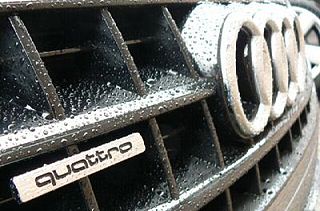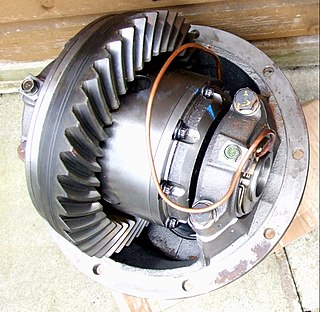Left-foot braking is the technique of using the left foot to operate the brake pedal in an automobile, leaving the right foot dedicated to the throttle pedal. It contrasts with the practice of using the left foot to operate the clutch pedal, leaving the right foot to share the duties of controlling both brake and gas pedals.
The handbrake turn is a driving technique used to deliberately slide a car sideways, either for the purpose of quickly negotiating a very tight bend, or for turning around well within the vehicle's own turning circle.
A traction control system (TCS), also known as ASR, is typically a secondary function of the electronic stability control (ESC) on production motor vehicles, designed to prevent loss of traction of the driven road wheels. TCS is activated when throttle input and engine power and torque transfer are mismatched to the road surface conditions.

Understeer and oversteer are vehicle dynamics terms used to describe the sensitivity of a vehicle to steering. Oversteer is what occurs when a car turns (steers) by more than the amount commanded by the driver. Conversely, understeer is what occurs when a car steers less than the amount commanded by the driver.

A limited-slip differential (LSD) is a type of differential that allows its two output shafts to rotate at different speeds but limits the maximum difference between the two shafts. Limited-slip differentials are often known by the generic trademark Positraction, a brand name owned by General Motors.

quattro is the trademark used by the automotive brand Audi to indicate that all-wheel drive (AWD) technologies or systems are used on specific models of its automobiles.
Automobile handling and vehicle handling are descriptions of the way a wheeled vehicle responds and reacts to the inputs of a driver, as well as how it moves along a track or road. It is commonly judged by how a vehicle performs particularly during cornering, acceleration, and braking as well as on the vehicle's directional stability when moving in steady state condition.

A locking differential is a mechanical component, commonly used in vehicles, designed to overcome the chief limitation of a standard open differential by essentially "locking" both wheels on an axle together as if on a common shaft. This forces both wheels to turn in unison, regardless of the traction available to either wheel individually.

Aquaplaning or hydroplaning by the tires of a road vehicle, aircraft or other wheeled vehicle occurs when a layer of water builds between the wheels of the vehicle and the road surface, leading to a loss of traction that prevents the vehicle from responding to control inputs. If it occurs to all wheels simultaneously, the vehicle becomes, in effect, an uncontrolled sled. Aquaplaning is a different phenomenon from when water on the surface of the roadway merely acts as a lubricant. Traction is diminished on wet pavement even when aquaplaning is not occurring.
Electronic brakeforce distribution or electronic brakeforce limitation (EBL) is an automobile brake technology that automatically varies the amount of force applied to each of a vehicle's wheels, based on road conditions, speed, loading, etc, thus providing intelligent control of both brake balance and overall brake force. Always coupled with anti-lock braking systems (ABS), EBD can apply more or less braking pressure to each wheel in order to maximize stopping power whilst maintaining vehicular control. Typically, the front end carries more weight and EBD distributes less braking pressure to the rear brakes so the rear brakes do not lock up and cause a skid. In some systems, EBD distributes more braking pressure at the rear brakes during initial brake application before the effects of weight transfer become apparent.

Drifting is a driving technique where the driver intentionally oversteers, with loss of traction, while maintaining control and driving the car through the entirety of a corner. The technique causes the rear slip angle to exceed the front slip angle to such an extent that often the front wheels are pointing in the opposite direction to the turn. Drifting is traditionally done by clutch kicking, then intentionally oversteering and countersteering. This sense of drift is not to be confused with the four wheel drift, a classic cornering technique established in Grand Prix and sports car racing.

Wheel alignment sometimes referred to as breaking, or tracking is part of standard automobile maintenance that consists of adjusting the angles of wheels to the car manufacturer specifications. The purpose of these adjustments is to reduce tire wear and to ensure that vehicle travel is straight and true. Alignment angles can also be altered beyond the maker's specifications to obtain a specific handling characteristic. Motorsport and off-road applications may call for angles to be adjusted well beyond normal, for a variety of reasons.

A burnout is the practice of keeping a vehicle stationary and spinning its wheels, the resultant friction causing the tires to heat up and smoke.

Trail braking is a driving and motorcycle riding technique where the brakes are used beyond the entrance to a turn (turn-in), and then gradually released. Depending on a number of factors, the driver fully releases brake pressure at any point between turn-in and the apex of the turn.

Fishtailing is a vehicle handling problem which occurs when the rear wheels lose traction, resulting in oversteer. This can be caused by low friction surfaces. Rear-drive vehicles with sufficient power can induce this loss of traction on any surface, which is called power-oversteer.
Lift-off oversteer is a form of oversteer in automobiles that occurs while cornering when closing the throttle causes a deceleration, causing the vertical load on the tires to shift from the rear to the front, in a process called Load transfer. This decrease in vertical load on the rear tires causes a decrease in the lateral force they generate, so that their lateral acceleration is also decreased. This causes the vehicle to steer more tightly into the turn, hence oversteering. In other words, easing off the accelerator can cause the rear tires to lose traction, with the potential for the car to leave the road tail first.

Bicycle and motorcycle dynamics is the science of the motion of bicycles and motorcycles and their components, due to the forces acting on them. Dynamics falls under a branch of physics known as classical mechanics. Bike motions of interest include balancing, steering, braking, accelerating, suspension activation, and vibration. The study of these motions began in the late 19th century and continues today.
S-AWC is the brand name of an advanced full-time four-wheel drive system developed by Mitsubishi Motors. The technology, specifically developed for the new 2007 Lancer Evolution, the 2010 Outlander, the 2014 Outlander, the Outlander PHEV and the Eclipse Cross have an advanced version of Mitsubishi Motors' AWC system. Mitsubishi Motors first exhibited S-AWC integration control technology in the Concept-X model at the 39th Tokyo Motor Show in 2005. According to Mitsubishi Motors, "the ultimate embodiment of the company's AWC philosophy is the S-AWC system, a 4WD-based integrated vehicle dynamics control system".
All Wheel Control (AWC) is the brand name of a four-wheel drive (4WD) system developed by Mitsubishi Motors. The system was first incorporated in the 2001 Lancer Evolution VII. Subsequent developments have led to S-AWC, developed specifically for the new 2007 Lancer Evolution. The system is referred by the company as its unique 4-wheel drive technology umbrella, cultivated through its motor sports activities and long history in rally racing spanning almost half a century.
An automobile skid is an automobile handling condition where one or more tires are slipping relative to the road, and the overall handling of the vehicle has been affected.












